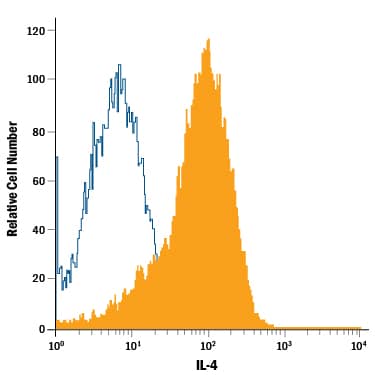Human IL-4 PE-conjugated Antibody
R&D Systems, part of Bio-Techne | Catalog # IC204P


Key Product Details
Species Reactivity
Validated:
Cited:
Applications
Validated:
Cited:
Label
Antibody Source
Product Specifications
Immunogen
His25-Ser153
Accession # P05112.1
Specificity
Clonality
Host
Isotype
Scientific Data Images for Human IL-4 PE-conjugated Antibody
Detection of IL‑4 in NS0 Mouse Cell Line Transfected with Human IL-4 by Flow Cytometry.
NS0 mouse myeloma cell line transfected with human IL-4 was stained with Mouse Anti-Human IL-4 PE-conjugated Monoclonal Antibody (Catalog # IC204P, filled histogram) or isotype control antibody (Catalog # IC002P, open histogram). To facilitate intracellular staining, cells were fixed with Flow Cytometry Fixation Buffer (Catalog # FC004) and permeabilized with Flow Cytometry Permeabilization/Wash Buffer I (Catalog # FC005). View our protocol for Staining Intracellular Molecules.Applications for Human IL-4 PE-conjugated Antibody
Intracellular Staining by Flow Cytometry
Sample: NS0 mouse myeloma cell line transfected with human IL-4 fixed with Flow Cytometry Fixation Buffer (Catalog # FC004) and permeabilized with Flow Cytometry Permeabilization/Wash Buffer I (Catalog # FC005)
Formulation, Preparation, and Storage
Purification
Formulation
Shipping
Stability & Storage
- 12 months from date of receipt, 2 to 8 °C as supplied.
Background: IL-4
Interleukin-4 (IL-4), also known as B cell-stimulatory factor-1, is a monomeric, approximately 13-18 kDa Th2 cytokine that shows pleiotropic effects during immune responses (1-3). It is a glycosylated polypeptide that contains three intrachain disulfide bridges and adopts a bundled four alpha-helix structure (4). Human IL-4 is synthesized with a 24 aa signal sequence. Alternate splicing generates an isoform with a 16 aa internal deletion. Mature human IL-4 shares 55%, 39%, and 43% aa sequence identity with bovine, mouse, and rat IL-4, respectively. Human, mouse, and rat IL-4 are species-specific in their activities (5-7). IL-4 exerts its effects through two receptor complexes (8, 9). The type I receptor, which is expressed on hematopoietic cells, is a heterodimer of the ligand binding IL-4 R alpha and the Common gamma Chain (a shared subunit of the receptors for IL-2, -7, -9, -15, and -21). The type II receptor on non-hematopoietic cells consists of IL-4 R alpha and IL-13 R alpha1. The type II receptor also transduces IL-13 mediated signals. IL-4 is primarily expressed by Th2-biased CD4+ T cells, mast cells, basophils, and eosinophils (1, 2). It promotes cell proliferation, survival, and immunoglobulin class switch to IgG4 and IgE in human B cells, acquisition of the Th2 phenotype by naïve CD4+ T cells, priming and chemotaxis of mast cells, eosinophils, and basophils, and the proliferation and activation of epithelial cells (10-13). IL-4 plays a dominant role in the development of allergic inflammation and asthma (12, 14).
References
- Benczik, M. and S.L. Gaffen (2004) Immunol. Invest. 33:109.
- Chomarat, P. and J. Banchereau (1998) Int. Rev. Immunol. 17:1.
- Yokota, T. et al. (1986) Proc. Natl. Acad. Sci. USA 83:5894.
- Redfield, C. et al. (1991) Biochemistry 30:11029.
- Ramirez, F. et al. (1988) J. Immunol. Meth. 221:141.
- Leitenberg, D. and T.L. Feldbush (1988) Cell. Immunol. 111:451.
- Mosman, T.R. et al. (1987) J. Immunol. 138:1813.
- Mueller, T.D. et al. (2002) Biochim. Biophys. Acta 1592:237.
- Nelms, K. et al. (1999) Annu. Rev. Immunol. 17:701.
- Paludan, S.R. (1998) Scand. J. Immunol. 48:459.
- Corthay, A. (2006) Scand. J. Immunol. 64:93.
- Ryan, J.J. et al. (2007) Crit. Rev. Immunol. 27:15.
- Grone, A. (2002) Vet. Immunol. Immunopathol. 88:1.
- Rosenberg, H.F. et al. (2007) J. Allergy Clin. Immunol. 119:1303.
Long Name
Alternate Names
Entrez Gene IDs
Gene Symbol
UniProt
Additional IL-4 Products
Product Documents for Human IL-4 PE-conjugated Antibody
Product Specific Notices for Human IL-4 PE-conjugated Antibody
For research use only